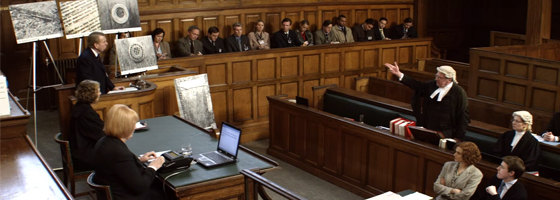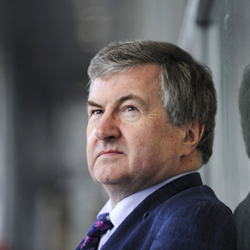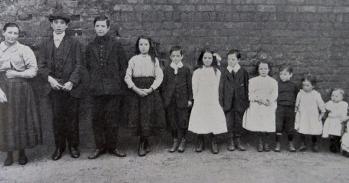
The new film Denial dramatises the landmark libel trial when David Irving sued the academic Deborah Lipstadt for calling him a Holocaust denier – a case Irving lost. Sir Richard Evans, Regius Professor of History and an authority on the Third Reich, was called as an expert witness in the trial. Here, Evans discusses the case and the film, the emergence of 'soft' Holocaust denial, and the statement put out by Trump's White House on this year's Holocaust Memorial Day.
The new film Denial dramatises the landmark libel trial when David Irving sued the academic Deborah Lipstadt for calling him a Holocaust denier – a case Irving lost. Sir Richard Evans, Regius Professor of History and an authority on the Third Reich, was called as an expert witness in the trial. Here, Evans discusses the case and the film, the emergence of 'soft' Holocaust denial, and the statement put out by Trump's White House on this year's Holocaust Memorial Day.
There is a new form of ‘soft’ Holocaust denial making itself heard: the suggestion that the mass murder of the Jews by the Nazis was just another genocide among many, however terrible it may have been. Anyone who has ever worked on Nazi Germany knows that this was not the case
Richard Evans
I only have a very small part in the film Denial compared to those of David Irving (played by Timothy Spall), Richard Rampton QC (played by Tom Wilkinson), Anthony Julius (played by Andrew Scott), and Professor Deborah Lipstadt (played by Rachel Weisz), but I like to think it’s an important one. When Irving sued Deborah Lipstadt and Penguin, her publishers, in the High Court for libeling him by calling him a Holocaust denier and a falsifier of history, Julius, as her solicitor, decided to defend her by proving that what she had written about Irving was true.
He asked me to go through Irving’s books, articles and speeches and address the issues at the centre of the case. With the help of two of my PhD students, who also appear in the film, I spent 18 months doing just that, and writing a 740-page report that was put before the court. We demonstrated that he was indeed a Holocaust denier, who had claimed that there was no Nazi policy of exterminating the Jews, that 6 million did not die as a result of it, that gas chambers were not used to carry it out, and that the evidence on which historians relied was forged.
Irving lost the case comprehensively. When the case was heard before the High Court in the early months of 2000, Irving was unable to shake the foundations of my report or the conclusions of several other expert witnesses who presented evidence on the gas chambers at Auschwitz, on the planning and implementation of what the Nazis euphemistically called “the Final Solution of the Jewish Question in Europe”, and on Irving’s connections with far-right, neo-Nazi groups.
In the film, John Sessions plays me incisively and with vigor as I give my evidence from the witness box. True, he only speaks for three or four minutes, whereas in the actual trial I was cross-examined by Irving for 28 hours, spread over more than a week. But the brilliant screenplay by David Hare gets over the essential point, which is that Irving deliberately falsified the historical evidence to bring it into conformity with his prejudices, his Holocaust denial. If all the egregious errors in his historical writings had been the result of mere carelessness then their effect on his arguments would have been random. But they all went to support his denial of Hitler’s responsibility for the Holocaust, the absence of any Nazi plan, and the claim that gas chambers were not used to kill vast numbers of Jews; so therefore they could only have been the result of deliberate falsification.
Irving wanted to argue, as he did in his opening statement, that Deborah Lipstadt was part of a Jewish conspiracy to discredit him. The judge did not permit him, however, to pursue this line in his closing statement. The allegation was irrelevant to the actual subject of the trial, which was Lipstadt’s charge that Irving was a falsifier of history and a Holocaust denier. Shifting the ground of an argument from the issues to the person who has raised them is a standard tactic of conspiracy theorists. They should not be allowed to get away with it.
In the end, by substantiating the defence of truth and accuracy in Lipstadt’s defamatory allegations, it was proved by implication that these things that Irving denied actually did happen. It was a victory for historical investigation. Seventeen years later, that victory no longer seems quite so comprehensive or secure. True, Irving was discredited in the eyes of the historical profession, some of whose members had previously taken his research seriously as scholarship. He also lost access to the newspapers and the broadcast media, where he had up to that point sometimes been treated as an expert on Nazism and the Second World War.

But the case was heard before the era of social media. Facebook was founded in 2004 and Twitter two years later. The Internet and the World Wide Web were already in existence, though their use was still not very widespread. These new institutions have transformed the nature of communication, putting out vast masses of unedited, undigested, uncontrolled information and, more importantly, misinformation out into the public arena.
The rapid and still largely unregulated spread of abusive ‘trolling’, the aggressive harassment of individuals through obscenities and even threats of violence and rape by social media, has introduced a new element venom into the public discourse. During and after the trial, I received a large number of abusive and obscene letters through the post from Irving’s supporters. I did not find them upsetting; they were uniformly stupid and many of them were semi-literate. I filed them away. Nobody ever saw any of them apart from those who wrote them, and myself, their recipient. But nowadays they would not be put into envelopes, they would go out there onto the Internet, via social media. This is a huge difference, and it’s degrading and defiling what should be a means of open and friendly communication, information and debate.
More importantly, however, while the trial, as it happened and as it is depicted in Denial, gave the stamp of the High Court, of the legal profession, of academic historians and political scientists, to the authenticity of the massive documentation that exists showing the Holocaust really happened, the emergence of social media and the proliferation of Holocaust-denying websites has allowed people who refuse to accept the facts to put their obnoxious opinions before the public as if they were statements of the truth.
What is at the core of Holocaust denial is of course anti-Semitism: in essence a vast and pernicious conspiracy theory that believes that there is a Jewish plot to convince the world that six million Jews were killed by the Nazis, and that the plot has only succeeded because ‘the Jews’ control the media and rule the world of academic historical research. This is of course utter nonsense, as we showed in court. Apart from anything else, Jewish communities everywhere are divided politically and socially, and the media and the newspapers are not controlled by Jews of any description acting in any kind of concert. Still less is this the case with universities and institutes of research that discover and publicize the huge mass of historical documentation now available on the Holocaust.
But all opinions are equal in the new public sphere of the Internet. And there is a new form of ‘soft’ Holocaust denial making itself heard: the suggestion that the mass murder of the Jews by the Nazis was just another genocide among many, however terrible it may have been. Anyone who has ever worked on Nazi Germany knows that this was not the case: while millions of others who were the victims of Nazism – ‘Slavs’, ‘Gypsies’, the mentally ill and handicapped, homosexuals, and others – were seen as obstacles to the rise of German power, the purity of the German race, and the implementation of German plans to  colonise eastern Europe, the Jews were regarded quite differently, as the ‘world-enemy’, engaged in a global conspiracy that aimed at the destruction of the German, or as the Nazis put it, ‘Aryan’ race. They were an existential threat, so had to be killed wherever they were found. That is the reason why they were singled out by the Nazis, and even by ordinary German soldiers during the invasions of Poland and Russia in 1939 and then 1941, for specially sadistic and humiliating treatment, unlike the Nazis’ other victims.
colonise eastern Europe, the Jews were regarded quite differently, as the ‘world-enemy’, engaged in a global conspiracy that aimed at the destruction of the German, or as the Nazis put it, ‘Aryan’ race. They were an existential threat, so had to be killed wherever they were found. That is the reason why they were singled out by the Nazis, and even by ordinary German soldiers during the invasions of Poland and Russia in 1939 and then 1941, for specially sadistic and humiliating treatment, unlike the Nazis’ other victims.
The ‘Final Solution’ was thus far more than just another set of massacres. That is why we commemorate it on Holocaust Memorial Day, on 27 January. Yet when the Trump White House put out a statement on the Day, it made no mention of the Jews at all. Questioned on this, a spokesman claimed that the President wanted the Day to be ‘inclusive’. But the Nazis weren’t inclusive: it was only the Jews whom they tried to exterminate everywhere they found them, in their millions, in gas chambers, ghettoes and shooting pits. Seemingly the kind of anti-Semitism that reared its ugly head during the US election campaign, with Trump’s claim that Hillary Clinton “meets in secret with international banks to plot the destruction of U.S. sovereignty” and that Jews “control the levers of power”, has now moved into the White House.
Hard and soft Holocaust denial are now back in business, thanks to the Internet and to social media. All we can do to counter them is to insist again and again on the facts. The release of Denial, I hope, has made and will continue to make a major contribution to the discrediting of these obnoxious and paranoid conspiracy theories.
This article was originally published by the Conspiracy & Democracy Project: a five-year, interdisciplinary research project at Cambridge aiming to provide a “natural history” of conspiracy theorising. Prof Sir Richard Evans (inset above) is a co-Director of the Project.

The text in this work is licensed under a Creative Commons Attribution 4.0 International License. For image use please see separate credits above.




